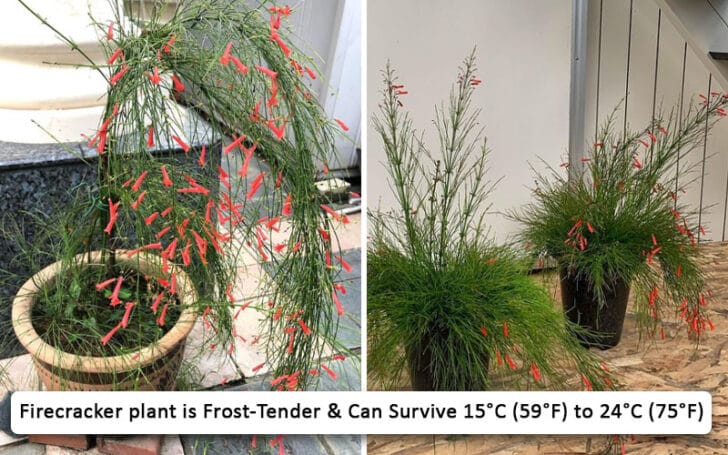Garden
Low-Effort Care Tips to Make Your Firecracker Plant Bloom All Year Round | Problems, Uses
If you google firecracker plant, the results are fireworks bush, coral plant, fountain bush, fireworks fern, coral fountain plant, etc.
But don’t get confused. All of these are different names for the firecracker plant, Russelia equisetiformis.
It would be fair to say that this beautiful crimson or slightly orange flowering perennial is an ideal houseplant for plant lovers who love to add a splash of color to their gardens.
They may seem like demanding plants, but to be honest, they are not. Yeah! It can be relatively easy to maintain if you follow the basic steps or instructions.
Let’s find out everything you can do for a thriving fireworks factory.
Firecracker Plant
Native to Mexico and Guatemala, russelia is a perennial with finely textured stems and red tubular flowers that resemble fireworks. It is a weeping subshrub (growing vertically) that stays low in moderate shade but can have tall cascades of showy red flowers in full sun.
However, what is a weeping subshrub? In general, a weeping tree is a plant variety or subshrub that characterizes soft drooping branches. These loose branches bend the flora downward, creating a waterfall of drooping flowers.
The binomial name russelia equisetiformis is pronounced ‘Russ-ELL-ee-uh Eck-wiss-ee-tiff-FOR-miss’.
Russell, named after Dr. Andrew Russell, equisetiformis comes from the Latin name equisætum, ‘horsetail plant’.
Here, read a quick fireworks plant introduction:
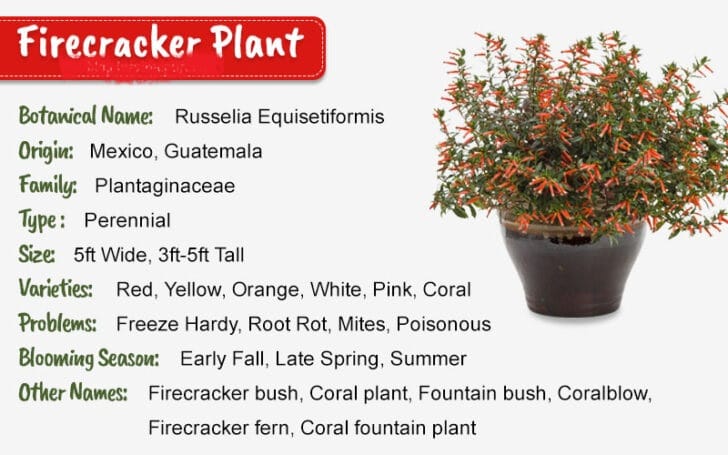
Yes, it was popular even back then. So, how can you place the beautiful fireworks bush in your home garden to fill the space with colorful and captivating red orange flowers?
Garden Merit Award
The broom-like semi-evergreen firecracker plant won the ‘Royal Horticultural Society’s Award of Garden Merit in 1993.
Let’s discuss in the next part of ‘Easy to Follow Fireworks Plant Care’.
Firecracker Plant Care
The firecracker plant is a sun-loving perennial that requires maximum light to produce successive red flowers. Put it outside in the summer and let it absorb the bright sunlight, but move it back indoors for the winter as it is frost sensitive. It needs medium watering and is among the drought tolerant plants.
Firecracker plant care is not difficult or difficult. Yeah! You just need to get all the basics right and your coral plant will get an evergreen life. Here are the easy-to-follow steps:
USDA Zone: 8B, 9, 10, 11
Light: Bright to Full sunlight (can tolerate moderate light but will be low; small size)
Soil Type: Well-drained soil or potting mix with a layer of perlite, sand and peat humus
Soil pH: Neutral (6.6-7.5), Slightly acidic (6.1-6.5) or alkaline (7.6-7.8)
Watering: Regularly or Weekly in Summer, Less in Winter (let topsoil dry between waterings)
Temperature: 15°C (59°F) to 24°C (75°F); Frost-Tender (Move Indoors in Winter)
Humidity Level: 40%
Propagation: Easy propagation in water, soil, sphagnum moss
Fertilizer: Controlled Release Fertilizer (Liquid) in Autumn, Spring and Summer
1. Light & Placement
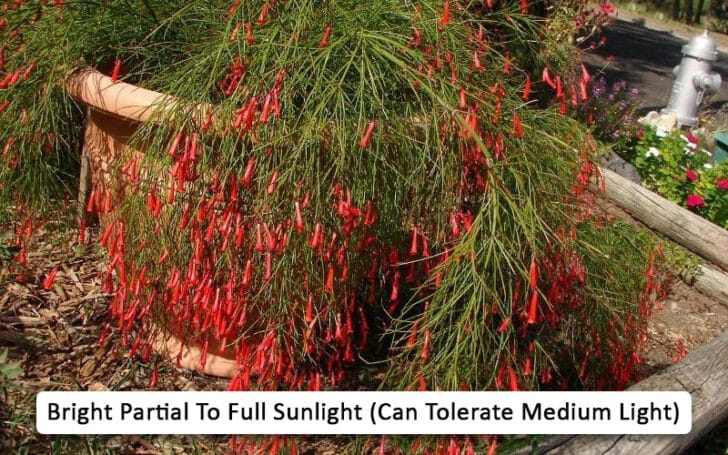
Mexican firecracker plant is a sun-loving perennial that will thrive with beautiful orange-red flowers in full to partial light.
Place the coral plant indoors in a location with maximum light to accommodate the warm ambient conditions of your region of Guatemala, United States-Florida or Mexico. A south-facing window can be the ideal location as it receives more light than a north-facing window.
However, if your home does not have a bright sunlight spot, be sure to choose an area with partial shade.
Note: Firecracker plants (small-sized plants that are tied to the ground, with fewer or no blooms) tend to experience moderate shade and low sunlight exposure.
2. Soil
Firecracker bush can be considered a forgiving plant when it comes to soil needs. Like Selenicerus Grandiflorus, it requires well-drained soil to sit in.
It can work well in almost any soil type such as clay, loam, sandy, chalky. If you want to plant in containers, choose a standard potting mix containing sand and perlite for proper drainage.
When it comes to soil pH for firecracker fern, it can survive in the slightly acidic to alkaline ranges. You can also add an organic layer of peat humus on top of the soil.
Check if the Soil Mixture is Perfect
Pour water over the soil mix prepared for fireworks plants and observe how quickly it drains from the soil type.
3. Water
The mature firecracker plant is drought tolerant and needs moderate watering. However, the young Russian requires an appropriate watering schedule during its early growth stages.
In the summer, when the temperature is hot, water the plant regularly with the sprayer to ensure it reaches every leaf and flower. Depending on your region, you can also follow a weekly watering routine.
Allow the soil to dry out between watering sessions, as Mexican firecrackers don’t like to sit in wet soil.
Note: Keep your plant a little dry by reducing the days of spraying during the winter months.
4. Temperature
Depending on their warm natural environment, the ideal temperature range for fireworks plant care is between 15°C (59°F) and 24°C (75°F). It can withstand a minimum of 12°C (54°F), but anything below it can cause the coral spring to dry out and die.
Firecracker flowers can survive the hot, hotter summer outdoors, but do not do well in freezing temperatures in the winter, as they are not frost tolerant. Therefore, it is best to bring this plant indoors during the cold season.
Remember to place it indoors in a bright location with the maximum amount of partial or full sunlight.
5. Fertilizer
Florida’s coral bushes bloom all year. What could be the reason? hot place? Full sun? Rich drainage soil?
Well, to mention the combination of all of these! If you want to see your firecracker plant bloom all year, you need to meet all the basic maintenance needs.
Fertilize your Russelia with a controlled-release liquid fertilizer (diluted to half strength) biweekly in fall-spring and monthly during winter.
Now you must be wondering why you should fertilize the firework flower with a controlled or slow-release fertilizer and not a standard fertilizer? The red fern plant first grows upright and then forms a vertically hanging waterfall of firework flowers. It tends to take up a lot of space around it.
And a typical fertilizer simply burns the plant-to-soil area without providing essential nutrients all over the firecracker tree.
Note: You can also add additional nutritional supplements containing a water-soluble fertilizer to promote and promote the intense blooming of flowers.
6. Humidity
Coral fountain is a drought tolerant plant. Yes, it can withstand low humidity, but that doesn’t mean it won’t appreciate a little more humidity. The ideal humidity level is 40%.
If you live in a somewhat dry area, there are three possible ways to increase your plant’s moisture level.
- Use an effective moisturizer
- Mist the leaves of the firecracker plant regularly
- Put a water-gravel tray under the pot
7. Potting & Repotting
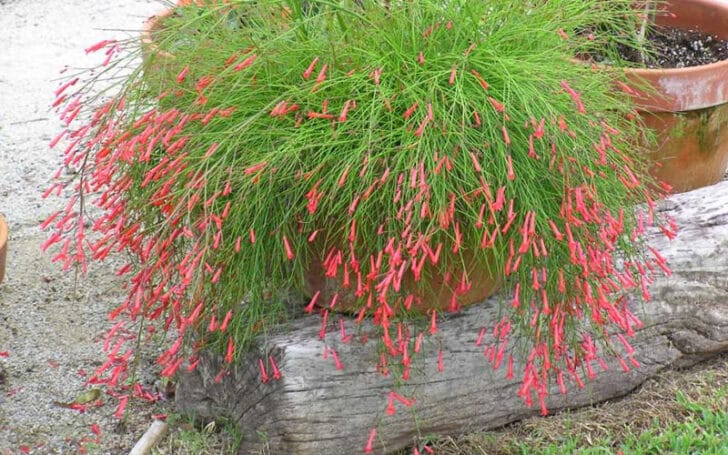
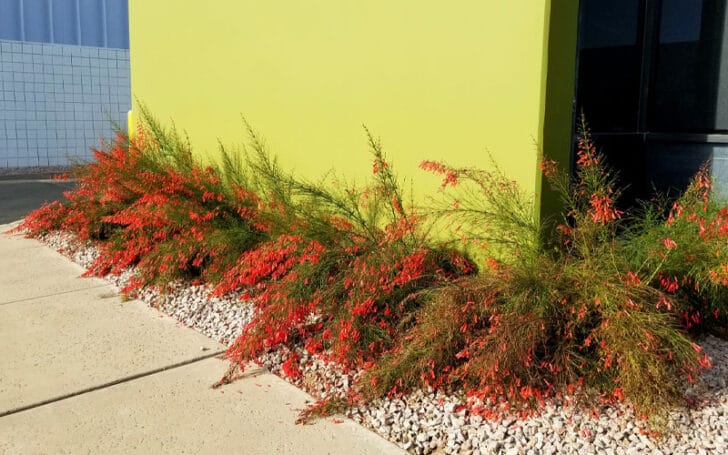
For potting fountain plants, choose a container or flowering pot that provides enough room for it to grow freely, i.e. allow the red tubular flower to spread. If you want to see them attract hummingbirds, you should choose to plant them in taller pots with drainage holes or place the potting bowl high.
But if you want to spread it over the ground, be sure to dig a small hole that’s the same depth and twice as wide as the firecracker root ball. Carefully place the coral plant in the hole and cover it with soil level with the ground.
When it comes to repotting, coral fountain grass needs to be transplanted annually. Choose to repot the plant at the beginning of the year. You can do this like this:
The first and most important step is to get a fresh, well-drained, nutrient-rich potting mix combined with previous potting soil. Place the old plant in a new pot.
Finally, regularly place this in a bright area with plenty of sun and water for best results.
Pro-Tip: Make mixing hassle-free with this foldable garden mat.
8. Propagation & Growth
Firebush plants show moderate to rapid growth when basic maintenance needs are met. The plant can grow 3ft to 6ft tall and 4ft to 6ft wider.
There are four ways to propagate red firework fern: division, layering, seeds and stem cutting. Of all the techniques, trunk cutting is considered the easiest. In contrast, new growth from seed requires providing the plant with moderate temperature, humidity, sunlight and irrigation needs.
Propagation of firecracker plant by stem cutting method:
Cut a trunk with a tree grafting kit 6 inches (two to three leaves) just below the node, plant it in new soil 3 inches outside the pot and within 3 inches of the soil.
Pro-Tip: Place freshly developed roots in a warm, bright room. Keep misting the growing plant regularly as it requires more maintenance.
9. Maintenance & Pruning
The inclusive growth, care, and health of the firecracker plant depend on pruning. How? Well, if you’ve even read the basic gardening tips and tricks for thriving plants, you should know that the beauty of the plant is preserved through pruning.
And, as we explained earlier, the fountain bush is popular because of its beautiful red tubular flowers. It also diffuses into the environment when adequate water, fertilizer and sunlight are provided. All of this makes the fix even more important.
So when is the best time to trim overgrown coral fountain shrubs? In summer or spring and at the end of winter.
Rejuvenating pruning is recommended for the coral plant every few years.
Pruning is done to protect the plants surrounding the growth from overcrowding, remove damaged nodes or cut off the affected leaves.
10. Flowering
Firecracker plant flowers continue to bloom all year long until the frost season, as they are not frost tolerant.
It produces stunning orange-red, white, scarlet, coral and pink flowers that can add a colorful touch to the beauty of your garden.
Although they continue to bloom all month long, peak bloom times can be considered summer, late spring or fall.
Landscape/Ornamental Uses of Firecracker Plant
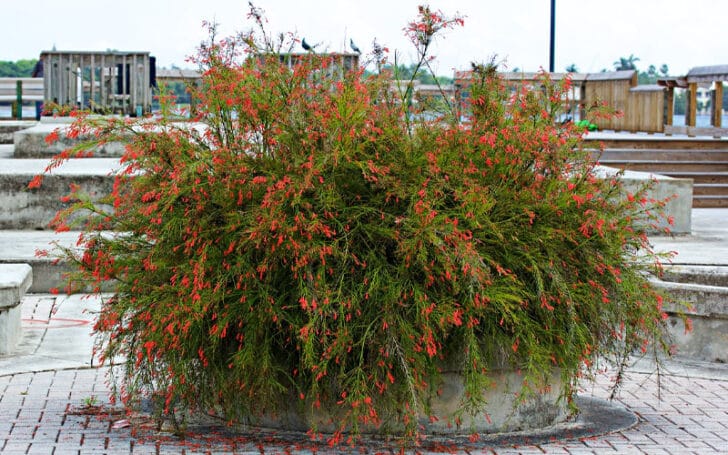
Decided to enhance the liveliness of your garden with firework flowers and lots of easy-to-grow lush grass? Here are some ways how you can use ornamental beauty for your home:
- Highlight your way
- A perfect hanging plant for your patio
- Store in containers to accentuate your porch
- Plant under palm trees
- Beautify the poolside
- Grow along fence to decorate outdoor
- Circle around the water fountain
Pro-Tip: If you want to enhance the beauty of your outdoor garden, plant colorful varieties of firecracker plant on an evergreen, biodegradable grass mat to further accentuate their pop.
This can make even a barren land look beautiful. Yeah! No more trouble beautifying your space!
Firecracker Plant Problems: FAQ
I. Is the firecracker plant poisonous or toxic?
Yeah! Yeah! And yes! Every part of the firecracker plant is poisonous and not edible for pets, children or anyone. However,
Its nectar-filled flowers attract hummingbirds, caterpillars or butterflies unharmed by this poison.
II. Is Firecracker Bush Invasive?
The fountain bush can outgrow surrounding vegetation if its primary care needs are met. They are considered invasive in the United States state of Florida, where they achieve an ideal warm environment.
So yes! If natural habitats are provided elsewhere, they can absorb resources from neighboring plants.
III. Where should I plant my coral fountain bush?
If you decide to pot them with other houseplants or are considering decorating your entryway with beautiful firecracker plants, be sure to keep a distance of 4ft-6ft so as not to let the surrounding area suffer.
IV. Can I grow a firecracker bush outdoors in Arizona or Florida?
Yeah! The cold resistance of the firecracker plant makes it popular in Alabama, Arizona, California, Florida, Georgia, Hawaii, Nevada, South Carolina, etc. It makes it ideal for potting outdoors in regions.
V. Why do my russelia equisetiformis have brown leaves?
It can be due to over watering or insufficient drainage. Make sure you follow the watering routine outlined above and choose a perforated pot.
VI. What are those dots on my firecracker plant?
Small dots indicate that your coral plant is under attack by spider mites or mealybugs.
A solution of liquid dish soap and equal parts of warm water mixed with 2 tablespoons of neem oil can help remove both. You can also add the insecticidal solution to a spray bottle and mist it all over your plant.
Conclusion
The firecracker plant is a beautiful perennial that produces red-orange tubular flowers almost all year round.
Also, firecracker plant care can become relatively easy if you master all the basic growth requirements needed to see coral bushes grow.
This fountain bush also has numerous ornamental or landscaping uses that can add a lively vibe to your lawn, patio, and outdoor hedge. What more do you need in a houseplant? I want to know? For more, visit the Molooco Gardening Category!
Finally, did you raise it? Or have you seen it somewhere in your area? Share your thoughts on this cascading plant in the comment section below.
Good planting friends!
Also, don’t forget to pin/bookmark and visit our blog for more interesting but original information.
